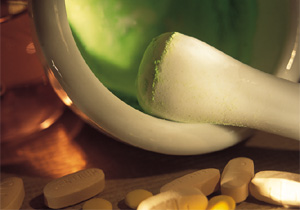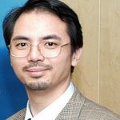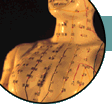|
 |
Introduction to TCM

Basics of TCM

• Yin-Yang | Five Elements

Zang-Fu Theories

• Zang Organs | Fu Organs

Classification of Antineoplastic Herbal Medicines

Characteristics of Herbal Medicines

Diagnose

• By Auscultation & Olfaction
• By Inspection

Prescriptions

Theories of Channels (Meridians) and Collaterals

Reference: A Modern View of the Immune System

Differentiation of Syndromes

• 8 Principles
• 6 Channels 4 Stages
• Syndromes of Zang-Fu Organs

Etiology

• Exogenous
| Pestilential
• Pathogenic Factors
• Emotional

Materia Medica


Back to Home

|
 |

Body Palpation
This is a diagnostic method to ascertain abnormal changes in the body
and to determine the location and nature of the disease through palpation
and finger pressure.
Palpating the Skin and Muscle
Generally, if there is excessive pathogenic heat in the body, the
patient will usually have heat on the body surface. Yang qi deficiency
has a cold body surface on palpation. If the surface feels hot on
first palpation becoming slightly hotter when you palpate longer,
this indicates that the pathogenic heat has proceeded from the exterior
to the interior of the body. Body palpation showing moist and smooth
skin demonstrates that the body fluid is not yet damaged. If the skin
and nails are very dry, this indicates consumption of the body fluids.
If body palpation shows swelling and further pressure makes a depression,
this indicates edema. If a depression appears on pressure and disappears
after taking the hand away, this indicates qi distension. Palpating the
skin can also indicate the patient's sweat condition.
Palpating Hands and Feet
Coldness of the four extremities is mostly due to yang deficiency
and excessive pathogenic cold. An overheating of the four extremities
indicates excessive heat. Coldness of the four extremities with heat
in the chest and abdomen is due to the retention of internal heat
preventing the flow of yang qi outward. Heat in the dorsum of the
hand is a sign of disease caused by exogenous pathogenic factors.
Palpating the Epigastrium and Abdomen
If the patient has fullness and distention of the hypochondrium,
palpation may demonstrate hardness and pain in this region. This
is known as an accumulation of excessive pathogenic factors in the
chest of the xu type. If the hardness extends over a large area in
the chest, it is due to phlegm-humor.
Palpation of the abdomen showing abdominal distention with a
tympanitic note on percussion, but with normal urination, indicates
qi tympanites. Abdominal distension with a splashing sound like water,
and accompanying dysuria indicates was tympanites or ascites. If hand
pressure relieves the abdominal pain, it is considered to be a xu type;
if the pain is made worse by pressure, it is a shi type. Immovable hard
masses in the abdomen with pain fixed in a certain area are due to
blood stasis. However, if the patient feels that lumps sometimes appear
and disappear with unfixed pain, and palpation of the abdomen shows
they do not exist, then this is due to qi stagnation.
Palpating Channels and Points
Clinical practice proves that in some diseases there may occur
tenderness or abnormal reactions along the courses of the affected
channels or at certain points. These signs have significance in
diagnosis by palpation, especially in acupuncture treatment. For
example, there may be tenderness at Pt. Zhongfu or Pt. Shufu, which
are closely related to the disorders of the lung and trachea. In
diseases of the heart and stomach, tenderness may occur at Pt. Jugue
of Ren, Pt. Zhongwan of Ren, Pt. Burong, or Pt. Liangmen. In disorders
of the liver and gall bladder, tenderness may be at Pt. Qimen and
Pt. Riye. In diseases of the spleen, tenderness may occur at
Pt. Zhangmen and Pt. Huangmen. In disorders of the kidney,
Pt. Jingmen and Pt. Zhishi may have tenderness. Tenderness at
Pt. Tianshu. Pt. Daji and Pt. Fujie may be closely related to
disorders of the intestines. Tenderness at Pt. Guanyan, Pt. Qihai
and Pt. Zhongji may have a close relation with disorders of the
urinogenital system. When there are abnormal reactions appearing
at the above points, they may reflect pathological changes of the
related zang or fu organs.
Read more on Pulse Feeling.
|

|
|
|
|
|
 |

|
WHAT IS TRADITIONAL CHINESE MEDICINE?

Photo © Image DJ Image Dictionary
With over 3000 years of experience, Traditional Chinese Medicine (TCM) has
remain one of the many fascinating areas in ancient Chinese culture.
First known to be documented in the Yellow Emperor's Canon of Medicine,
TCM is believed to have been practised in as early as 475 to 221 B.C.
The field of working knowledge of TCM stretches from anything related to
general healthcare practice to the philosophy of the mind, the logic of life,
religion, and even to as far as cosmology and astronumerology. This is why
in order to thoroughly understand the concepts behind TCM, one must be
comprehensive in learning and embracing the Chinese culture as a whole.
Just as Douglas Hoff put it when he explained about accupuncture, "The systems
of TCM uses the concepts of elements and meridians and are completely immersed
in the Asian cosmology which takes shape through the religions." The meridian-brain mechanism,
the fundamental working concept of acupuncture, in which the pain block from the message
that the needle or burning cone of herbs gives to the point of stimulus,
was only found centuries later by the West through science and technology.
|
| |
|
MESSAGE FROM THE EDITOR – MARCH 2020
 Thank you for visiting this TCM and acupuncture information website.
If you have previously been to this website, you might have
noticed that some of the pages on ancient historical ideas and
holistic thinkings related to Chinese metaphysics are temporarily taken offline.
This is because I will be revamping the whole website and be moving
those information into a new \"Ancient Chinese Culture\" section
so as to reflect a more current perspective on the interpretation
of some of the fundamental concepts as well as to include
some of the latest information in the area.
But if you have just found this website for the very first time, I welcome you again and
wish you could find what you require and, hopefully, you could also be benefitted
from reading the articles I published on this website.
Thank you for visiting this TCM and acupuncture information website.
If you have previously been to this website, you might have
noticed that some of the pages on ancient historical ideas and
holistic thinkings related to Chinese metaphysics are temporarily taken offline.
This is because I will be revamping the whole website and be moving
those information into a new \"Ancient Chinese Culture\" section
so as to reflect a more current perspective on the interpretation
of some of the fundamental concepts as well as to include
some of the latest information in the area.
But if you have just found this website for the very first time, I welcome you again and
wish you could find what you require and, hopefully, you could also be benefitted
from reading the articles I published on this website.
Please be patient and do come and check out this website frequently as it's being revamped.
Raymond Cheng, PhD DPA FRSA FRSPH

March 28, 2020.
|

|
IMPORTANT NOTICE AND DISCLAIMER

 This website is published, edited and designed by Raymond Cheng,
and reflects only and only his personal views and opinions in his individual capacity.
The information available at this website is not intended
directly or by implication to either diagnose or treat any
medical, emotional, or psychological condition or disorder.
It is also not intended to create a physician-patient relationship
between you and I or between you and Wyith Institute™ and The Office of Dr Raymond K K Cheng.
The information here is not a substitute for advice and treatment provided
by your physician or by another healthcare professional.
It is always recommended that consultation with local healthcare providers
be obtained for any of your specific health or medical concerns.
Furthermore, any products that can be purchased (yet you can see I don't have much
to sell here) through advertisers' banners or through links to other websites
are not either explicitly or implicitly given any warranty or endorsement
by me, my colleagues, Wyith Institute™ or any of its associated businesses.
This website is published, edited and designed by Raymond Cheng,
and reflects only and only his personal views and opinions in his individual capacity.
The information available at this website is not intended
directly or by implication to either diagnose or treat any
medical, emotional, or psychological condition or disorder.
It is also not intended to create a physician-patient relationship
between you and I or between you and Wyith Institute™ and The Office of Dr Raymond K K Cheng.
The information here is not a substitute for advice and treatment provided
by your physician or by another healthcare professional.
It is always recommended that consultation with local healthcare providers
be obtained for any of your specific health or medical concerns.
Furthermore, any products that can be purchased (yet you can see I don't have much
to sell here) through advertisers' banners or through links to other websites
are not either explicitly or implicitly given any warranty or endorsement
by me, my colleagues, Wyith Institute™ or any of its associated businesses.
|

|
|

 This website is published, edited and designed by Raymond Cheng,
and reflects only and only his personal views and opinions in his individual capacity.
The information available at this website is not intended
directly or by implication to either diagnose or treat any
medical, emotional, or psychological condition or disorder.
It is also not intended to create a physician-patient relationship
between you and I or between you and Wyith Institute™ and The Office of Dr Raymond K K Cheng.
The information here is not a substitute for advice and treatment provided
by your physician or by another healthcare professional.
It is always recommended that consultation with local healthcare providers
be obtained for any of your specific health or medical concerns.
Furthermore, any products that can be purchased (yet you can see I don't have much
to sell here) through advertisers' banners or through links to other websites
are not either explicitly or implicitly given any warranty or endorsement
by me, my colleagues, Wyith Institute™ or any of its associated businesses.
This website is published, edited and designed by Raymond Cheng,
and reflects only and only his personal views and opinions in his individual capacity.
The information available at this website is not intended
directly or by implication to either diagnose or treat any
medical, emotional, or psychological condition or disorder.
It is also not intended to create a physician-patient relationship
between you and I or between you and Wyith Institute™ and The Office of Dr Raymond K K Cheng.
The information here is not a substitute for advice and treatment provided
by your physician or by another healthcare professional.
It is always recommended that consultation with local healthcare providers
be obtained for any of your specific health or medical concerns.
Furthermore, any products that can be purchased (yet you can see I don't have much
to sell here) through advertisers' banners or through links to other websites
are not either explicitly or implicitly given any warranty or endorsement
by me, my colleagues, Wyith Institute™ or any of its associated businesses.



 Thank you for visiting this TCM and acupuncture information website.
If you have previously been to this website, you might have
noticed that some of the pages on ancient historical ideas and
holistic thinkings related to Chinese metaphysics are temporarily taken offline.
This is because I will be revamping the whole website and be moving
those information into a new \"Ancient Chinese Culture\" section
so as to reflect a more current perspective on the interpretation
of some of the fundamental concepts as well as to include
some of the latest information in the area.
But if you have just found this website for the very first time, I welcome you again and
wish you could find what you require and, hopefully, you could also be benefitted
from reading the articles I published on this website.
Thank you for visiting this TCM and acupuncture information website.
If you have previously been to this website, you might have
noticed that some of the pages on ancient historical ideas and
holistic thinkings related to Chinese metaphysics are temporarily taken offline.
This is because I will be revamping the whole website and be moving
those information into a new \"Ancient Chinese Culture\" section
so as to reflect a more current perspective on the interpretation
of some of the fundamental concepts as well as to include
some of the latest information in the area.
But if you have just found this website for the very first time, I welcome you again and
wish you could find what you require and, hopefully, you could also be benefitted
from reading the articles I published on this website.